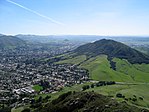San Luis Obispo County (/sæn ˌluːɪs oʊˈbɪspoʊ/ ), officially the County of San Luis Obispo, is a county on the Central Coast of California. As of the 2020 census, the population was 282,424.[10] The county seat is San Luis Obispo.[11]
San Luis Obispo County | |
|---|---|
| County of San Luis Obispo | |
Images, from top down, left to right: Cerro San Luis (Mountain) in San Luis Obispo, a vineyard in Paso Robles, Pismo Beach, Mission San Miguel Arcángel, Neptune Pool at Hearst Castle, Morro Rock | |
| Motto: "Not For Ourselves Alone" | |
 Interactive map of San Luis Obispo County | |
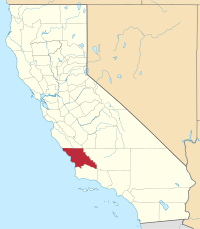 Location in the state of California | |
| Country | United States |
| State | California |
| Region | California Central Coast |
| Incorporated | February 18, 1850[1] |
| Named for | Saint Louis, Bishop of Toulouse |
| County seat | San Luis Obispo |
| Largest city (Population) | San Luis Obispo |
| Largest city (Area) | Atascadero |
| Government | |
| • Type | Council–Administration |
| • Body | San Luis Obispo County Board of Supervisors[2][3][4][5][6] |
| • Chair[7] | John Peschong (R) |
| • Vice Chair[7] | Debbie Arnold (R) |
| • Supervisors[7] | |
| • County Administrator[8] | Wade Horton |
| Area | |
| • Total | 3,616 sq mi (9,370 km2) |
| • Land | 3,299 sq mi (8,540 km2) |
| • Water | 317 sq mi (820 km2) |
| Highest elevation | 5,109 ft (1,557 m) |
| Population (2020) | |
| • Total | 282,424 |
| • Density | 86/sq mi (33/km2) |
| Time zone | UTC-8 (Pacific Time Zone) |
| • Summer (DST) | UTC-7 (Pacific Daylight Time) |
| Area code | 805 |
| Congressional district | 24th |
| Website | https://www.slocounty.ca.gov/ |
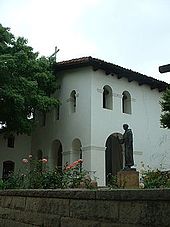

Junípero Serra founded the Mission San Luis Obispo de Tolosa in 1772, and San Luis Obispo grew around it. The small size of the county's communities, scattered along the beaches, coastal hills, and mountains of the Santa Lucia range, provides a wide variety of coastal and inland hill ecologies to support fishing, agriculture, and tourist activities.
California Polytechnic State University has almost 20,000 students. Tourism, especially for the wineries, is popular. Grapes and other agriculture products are an important part of the economy. San Luis Obispo County is the third largest producer of wine in California, surpassed only by Sonoma and Napa counties. Strawberries are the largest agricultural crop in the county.[12]
The town of San Simeon is located at the foot of the ridge where newspaper publisher William Randolph Hearst built Hearst Castle. Other coastal towns (listed from north to south) include Cambria, Cayucos, Morro Bay, and Los Osos -Baywood Park. These cities and villages are located northwest of the city of San Luis Obispo. To the south are Avila Beach and the Five Cities region. The Five Cities originally were: Arroyo Grande, Grover Beach (then known as Grover City), Oceano, Fair Oaks and Halcyon. Today, the Five Cities region consists of Pismo Beach, Grover Beach, Arroyo Grande, Oceano, and Halcyon (basically the area from Pismo Beach to Oceano). Just south of the Five Cities, San Luis Obispo County borders northern Santa Barbara County. Inland, the cities of Paso Robles, Templeton, and Atascadero lie along the Salinas River, near the Paso Robles wine region. San Luis Obispo lies south of Atascadero and north of the Five Cities region.
History
editThe prehistory of San Luis Obispo County is strongly influenced by the Chumash people. There has been significant settlement here at least as early as the Millingstone Horizon thousands of years ago. Important settlements existed in coastal areas such as Morro Bay and Los Osos.[13][14]
Mission San Luis Obispo de Tolosa was founded on September 1, 1772, in the area that is now the city of San Luis Obispo. The namesake of the mission, city and county is Saint Louis of Toulouse, the young bishop of Toulouse (Obispo and Tolosa in Spanish) in 1297.
San Luis Obispo County was one of the original counties of California, created in 1850 at the time of statehood.
The Salinas River Valley, a region that figures strongly in several John Steinbeck novels, stretches north from San Luis Obispo County.
Geography
edit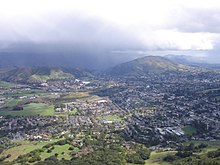

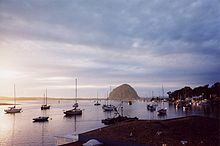
According to the U.S. Census Bureau, the county has a total area of 3,616 square miles (9,370 km2), of which 3,299 square miles (8,540 km2) is land and 317 square miles (820 km2) (comprising 8.8%) is water.[15]
Climate
edit
San Luis Obispo County has three main climate types. BSk climate can mainly be found in the eastern portions of the county, along with certain smaller areas in the north. Csa climate can mainly be found in the central portions of the counties, in communities such as Paso Robles. The rest of the county is made up of the Csb climate type. The Csb warm-summer mediterranean type climate together with the county's varied landscapes reminds visitors of European locales.[16]
Adjacent counties
editNational protected areas
edit- Carrizo Plain National Monument (part)
- Guadalupe-Nipomo Dunes National Wildlife Refuge (part)
- Los Padres National Forest (part)
Marine Protected Areas
edit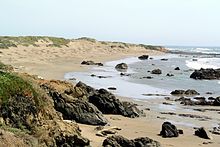
- Piedras Blancas State Marine Reserve and Marine Conservation Area
- Cambria State Marine Conservation Area
- White Rock (Cambria) State Marine Conservation Area
- Morro Bay State Marine Recreational Management Area and Morro Bay State Marine Reserve
- Point Buchon State Marine Reserve and Marine Conservation Area
Demographics
edit| Census | Pop. | Note | %± |
|---|---|---|---|
| 1850 | 336 | — | |
| 1860 | 1,782 | 430.4% | |
| 1870 | 4,772 | 167.8% | |
| 1880 | 9,142 | 91.6% | |
| 1890 | 16,072 | 75.8% | |
| 1900 | 16,637 | 3.5% | |
| 1910 | 19,383 | 16.5% | |
| 1920 | 21,893 | 12.9% | |
| 1930 | 29,613 | 35.3% | |
| 1940 | 33,246 | 12.3% | |
| 1950 | 51,417 | 54.7% | |
| 1960 | 81,044 | 57.6% | |
| 1970 | 105,690 | 30.4% | |
| 1980 | 155,435 | 47.1% | |
| 1990 | 217,162 | 39.7% | |
| 2000 | 246,681 | 13.6% | |
| 2010 | 269,637 | 9.3% | |
| 2020 | 282,424 | 4.7% | |
| 2023 (est.) | 281,639 | [17] | −0.3% |
| U.S. Decennial Census[18] 1790–1960[19] 1900–1990[20] 1990–2000[21] 2010[22] 2020[23] | |||
2020 census
edit| Race / Ethnicity | Pop 2010[22] | Pop 2020[23] | % 2010 | % 2020 |
|---|---|---|---|---|
| White alone (NH) | 191,696 | 183,468 | 71.09% | 64.96% |
| Black or African American alone (NH) | 5,128 | 4,330 | 1.90% | 1.53% |
| Native American or Alaska Native alone (NH) | 1,367 | 1,136 | 0.51% | 0.40% |
| Asian alone (NH) | 8,106 | 10,001 | 3.01% | 3.54% |
| Pacific Islander alone (NH) | 346 | 340 | 0.13% | 0.12% |
| Some Other Race alone (NH) | 784 | 1,614 | 0.29% | 0.57% |
| Mixed Race/Multi-Racial (NH) | 6,237 | 13,614 | 2.31% | 4.82% |
| Hispanic or Latino (any race) | 55,973 | 67,921 | 20.76% | 24.05% |
| Total | 269,637 | 282,424 | 100.00% | 100.00% |
Note: the US Census treats Hispanic/Latino as an ethnic category. This table excludes Latinos from the racial categories and assigns them to a separate category. Hispanics/Latinos can be of any race.
2011
edit| Population, race, and income | |||||
|---|---|---|---|---|---|
| Total population[24] | 267,871 | ||||
| White[24] | 224,800 | 83.9% | |||
| Black or African American[24] | 5,882 | 2.2% | |||
| American Indian or Alaska Native[24] | 2,625 | 1.0% | |||
| Asian[24] | 8,693 | 3.2% | |||
| Native Hawaiian or other Pacific Islander[24] | 280 | 0.1% | |||
| Some other race[24] | 16,666 | 6.2% | |||
| Two or more races[24] | 8,925 | 3.3% | |||
| Hispanic or Latino (of any race)[25] | 54,537 | 20.4% | |||
| Per capita income[26] | $30,204 | ||||
| Median household income[27] | $58,630 | ||||
| Median family income[28] | $74,841 | ||||
Places by population, race, and income
edit| Places by population and race | ||||||||
|---|---|---|---|---|---|---|---|---|
| Place | Type[29] | Population[24] | White[24] | Other[24] [note 1] | Asian[24] | Black or African American[24] | Native American[24] [note 2] | Hispanic or Latino (of any race)[25] |
| Arroyo Grande | City | 17,132 | 85.8% | 6.7% | 5.0% | 1.6% | 0.8% | 12.7% |
| Atascadero | City | 28,194 | 88.5% | 5.7% | 1.7% | 1.7% | 2.4% | 13.7% |
| Avila Beach | CDP | 1,086 | 91.4% | 8.6% | 0.0% | 0.0% | 0.0% | 2.2% |
| Blacklake | CDP | 1,014 | 97.1% | 0.0% | 1.5% | 0.0% | 1.4% | 0.8% |
| Callender | CDP | 1,531 | 96.3% | 2.2% | 1.6% | 0.0% | 0.0% | 42.5% |
| Cambria | CDP | 6,229 | 91.7% | 4.3% | 2.7% | 0.0% | 1.3% | 17.1% |
| Cayucos | CDP | 2,822 | 97.5% | 1.8% | 0.5% | 0.0% | 0.2% | 6.0% |
| Creston | CDP | 94 | 79.8% | 20.2% | 0.0% | 0.0% | 0.0% | 0.0% |
| Edna | CDP | 80 | 100.0% | 0.0% | 0.0% | 0.0% | 0.0% | 0.0% |
| El Paso de Robles (Paso Robles) | City | 29,270 | 76.6% | 15.1% | 2.0% | 4.5% | 1.8% | 35.1% |
| Garden Farms | CDP | 335 | 100.0% | 0.0% | 0.0% | 0.0% | 0.0% | 0.0% |
| Grover Beach | City | 13,175 | 81.6% | 9.9% | 6.0% | 1.4% | 1.0% | 21.0% |
| Lake Nacimiento | CDP | 2,397 | 96.0% | 4.0% | 0.0% | 0.0% | 0.0% | 12.3% |
| Los Berros | CDP | 920 | 86.2% | 13.8% | 0.0% | 0.0% | 0.0% | 19.8% |
| Los Osos | CDP | 14,950 | 85.3% | 7.5% | 6.3% | 0.4% | 0.5% | 12.4% |
| Los Ranchos | CDP | 1,578 | 91.4% | 3.1% | 1.5% | 0.8% | 3.2% | 2.1% |
| Morro Bay | City | 10,263 | 96.0% | 1.7% | 1.8% | 0.1% | 0.4% | 17.8% |
| Nipomo | CDP | 16,622 | 84.1% | 12.7% | 1.3% | 1.3% | 0.6% | 35.0% |
| Oak Shores | CDP | 187 | 100.0% | 0.0% | 0.0% | 0.0% | 0.0% | 5.3% |
| Oceano | CDP | 7,456 | 77.3% | 19.4% | 1.5% | 0.0% | 1.8% | 47.6% |
| Pismo Beach | City | 7,753 | 87.6% | 7.7% | 2.8% | 0.6% | 1.3% | 10.3% |
| San Luis Obispo | City | 45,130 | 83.2% | 8.4% | 6.4% | 1.6% | 0.6% | 16.6% |
| San Miguel | CDP | 2,782 | 64.6% | 29.6% | 1.3% | 0.0% | 4.6% | 50.8% |
| San Simeon | CDP | 571 | 48.0% | 52.0% | 0.0% | 0.0% | 0.0% | 72.5% |
| Santa Margarita | CDP | 1,429 | 95.7% | 4.3% | 0.0% | 0.0% | 0.0% | 18.0% |
| Shandon | CDP | 1,150 | 82.3% | 6.9% | 0.0% | 10.6% | 0.3% | 46.1% |
| Templeton | CDP | 7,645 | 88.9% | 9.5% | 0.7% | 0.5% | 0.4% | 16.4% |
| Whitley Gardens | CDP | 244 | 58.6% | 33.6% | 0.0% | 7.8% | 0.0% | 41.4% |
| Woodlands | CDP | 417 | 89.2% | 3.6% | 3.8% | 0.0% | 3.4% | 11.8% |
| Places by population and income | |||||
|---|---|---|---|---|---|
| Place | Type[29] | Population[30] | Per capita income[26] | Median household income[27] | Median family income[28] |
| Arroyo Grande | City | 17,132 | $34,489 | $64,900 | $79,188 |
| Atascadero | City | 28,194 | $32,153 | $68,502 | $79,818 |
| Avila Beach | CDP | 1,086 | $45,863 | $65,483 | $42,107 |
| Blacklake | CDP | 1,014 | $43,698 | $81,417 | $105,152 |
| Callender | CDP | 1,531 | $25,222 | $72,917 | $91,852 |
| Cambria | CDP | 6,229 | $46,892 | $76,271 | $99,550 |
| Cayucos | CDP | 2,822 | $38,525 | $59,130 | $69,861 |
| Creston | CDP | 94 | $43,934 | $85,357 | $81,250 |
| Edna | CDP | 80 | $71,853 | $115,962 | $115,962 |
| El Paso de Robles (Paso Robles) | City | 29,270 | $26,547 | $57,927 | $63,864 |
| Garden Farms | CDP | 335 | $61,822 | $111,360 | $111,360 |
| Grover Beach | City | 13,175 | $25,232 | $47,708 | $63,354 |
| Lake Nacimiento | CDP | 2,397 | $31,410 | $58,542 | $62,760 |
| Los Berros | CDP | 920 | $15,603 | $36,096 | $36,776 |
| Los Osos | CDP | 14,950 | $30,967 | $57,500 | $73,027 |
| Los Ranchos | CDP | 1,578 | $59,646 | $99,028 | $104,455 |
| Morro Bay | City | 10,263 | $33,137 | $52,582 | $65,833 |
| Nipomo | CDP | 16,622 | $26,014 | $61,265 | $68,386 |
| Oak Shores | CDP | 187 | $44,498 | $97,639 | $98,542 |
| Oceano | CDP | 7,456 | $18,363 | $37,219 | $40,489 |
| Pismo Beach | City | 7,753 | $44,250 | $65,682 | $88,971 |
| San Luis Obispo | City | 45,130 | $25,775 | $42,528 | $80,560 |
| San Miguel | CDP | 2,782 | $17,371 | $49,097 | $42,296 |
| San Simeon | CDP | 571 | $20,490 | $44,583 | $51,786 |
| Santa Margarita | CDP | 1,429 | $19,328 | $49,032 | $58,672 |
| Shandon | CDP | 1,150 | $19,050 | $65,260 | $59,167 |
| Templeton | CDP | 7,645 | $35,743 | $70,820 | $92,169 |
| Whitley Gardens | CDP | 244 | $21,938 | $106,250 | $129,000 |
| Woodlands | CDP | 417 | $54,163 | $96,250 | $89,250 |
2010
editThe 2010 United States Census reported that San Luis Obispo County had a population of 269,637. The racial makeup of San Luis Obispo County was 222,756 (82.6%) White, 5,550 (2.1%) African American, 2,536 (0.9%) Native American, 8,507 (3.2%) Asian (1.0% Filipino, 0.6% Chinese, 0.4% Japanese, 0.3% Indian, 0.3% Korean, 0.2% Vietnamese), 389 (0.1%) Pacific Islander, 19,786 (7.3%) from other races, and 10,113 (3.8%) from two or more races. Hispanic or Latino of any race were 55,973 persons (20.8%); 17.7% of San Luis Obispo County is Mexican, 0.3% Puerto Rican, and 0.2% Salvadoran.[31]
| Population reported at 2010 United States Census | |||||||||
|---|---|---|---|---|---|---|---|---|---|
| The County | Total Population | White | African American | Native American | Asian | Pacific Islander | other races | two or more races | Hispanic or Latino (of any race) |
| San Luis Obispo County | 269,637 | 222,756 | 5,550 | 2,536 | 8,507 | 389 | 19,786 | 10,113 | 55,973 |
| Incorporated cities | Total Population | White | African American | Native American | Asian | Pacific Islander | other races | two or more races | Hispanic or Latino (of any race) |
| Arroyo Grande | 17,252 | 14,710 | 156 | 125 | 595 | 14 | 856 | 796 | 2,707 |
| Atascadero | 28,310 | 24,457 | 585 | 295 | 685 | 57 | 1,205 | 1,026 | 4,429 |
| Grover Beach | 13,156 | 9,964 | 146 | 186 | 542 | 35 | 1,582 | 701 | 3,840 |
| Morro Bay | 10,234 | 8,909 | 44 | 92 | 258 | 9 | 613 | 309 | 1,526 |
| Paso Robles | 29,793 | 23,158 | 622 | 297 | 593 | 56 | 3,916 | 1,151 | 10,275 |
| Pismo Beach | 7,655 | 6,976 | 50 | 41 | 203 | 11 | 170 | 204 | 715 |
| San Luis Obispo | 45,119 | 38,117 | 523 | 275 | 2,350 | 65 | 1,973 | 1,816 | 6,626 |
| Census-designated places | Total Population | White | African American | Native American | Asian | Pacific Islander | other races | two or more races | Hispanic or Latino (of any race) |
| Avila Beach | 1,627 | 1,507 | 13 | 7 | 33 | 0 | 34 | 33 | 111 |
| Blacklake | 930 | 865 | 8 | 7 | 24 | 0 | 14 | 12 | 70 |
| Callender | 1,262 | 1,003 | 7 | 22 | 48 | 0 | 128 | 54 | 355 |
| Cambria | 6,032 | 5,166 | 18 | 47 | 78 | 14 | 557 | 152 | 1,187 |
| Cayucos | 2,592 | 2,366 | 6 | 12 | 54 | 8 | 57 | 89 | 207 |
| Creston | 94 | 89 | 0 | 2 | 1 | 0 | 0 | 2 | 6 |
| Edna | 193 | 185 | 0 | 3 | 0 | 0 | 5 | 0 | 22 |
| Garden Farms | 386 | 348 | 2 | 2 | 5 | 0 | 21 | 8 | 40 |
| Lake Nacimiento | 2,411 | 2,153 | 12 | 44 | 24 | 5 | 75 | 98 | 256 |
| Los Berros | 641 | 527 | 4 | 1 | 12 | 1 | 45 | 51 | 153 |
| Los Osos | 14,276 | 12,304 | 79 | 97 | 748 | 18 | 552 | 478 | 1,977 |
| Los Ranchos | 1,477 | 1,389 | 1 | 2 | 31 | 0 | 18 | 36 | 58 |
| Nipomo | 16,714 | 12,281 | 177 | 200 | 421 | 33 | 2,821 | 781 | 6,645 |
| Oak Shores | 337 | 318 | 3 | 2 | 4 | 0 | 4 | 6 | 31 |
| Oceano | 7,286 | 5,105 | 62 | 120 | 165 | 7 | 1,509 | 318 | 3,484 |
| San Miguel | 2,336 | 1,638 | 65 | 58 | 19 | 1 | 474 | 81 | 1,196 |
| San Simeon | 462 | 270 | 4 | 5 | 9 | 2 | 160 | 12 | 258 |
| Santa Margarita | 1,259 | 1,077 | 8 | 28 | 34 | 0 | 42 | 70 | 206 |
| Shandon | 1,295 | 840 | 34 | 18 | 7 | 2 | 352 | 42 | 693 |
| Templeton | 7,674 | 6,833 | 59 | 80 | 123 | 10 | 337 | 232 | 1,171 |
| Whitley Gardens | 285 | 260 | 1 | 6 | 1 | 0 | 13 | 4 | 43 |
| Woodlands | 576 | 541 | 7 | 0 | 18 | 1 | 3 | 6 | 27 |
| Other unincorporated areas | Total Population | White | African American | Native American | Asian | Pacific Islander | other races | two or more races | Hispanic or Latino (of any race) |
| All others not CDPs (combined) | 47,973 | 39,400 | 2,854 | 462 | 1,422 | 40 | 2,250 | 1,545 | 7,659 |
2000 Census
editAs of the census[32] of 2000, there were 246,681 residents, 92,739 households, and 58,611 families in the county. The population density was 75 people per square mile (29 people/km2). There were 102,275 housing units at an average density of 31 units per square mile (12 units/km2). The racial makeup of the county was 84.6% White, 2.0% Black or African American, 1.0% Native American, 2.7% Asian, 0.1% Pacific Islander, 6.2% from other races, and 3.4% from two or more races. 16.3% of the population were Hispanic or Latino of any race. 13.9% were of German, 11.4% English, 9.7% Irish, 6.1% American and 5.7% Italian ancestry according to Census 2000. 85.7% spoke English and 10.7% Spanish as their first language.
There were 92,739 households, out of which 28.2% had children under the age of 18 living with them, 50.40% were married couples living together, 9.1% had a female householder with no husband present, and 36.8% were non-families. 26.0% of all households were made up of individuals, and 10.3% had someone living alone who was 65 years of age or older. The average household size was 2.49 and the average family size was 3.01.
In the county, the population was spread out, with 21.7% under the age of 18, 13.6% from 18 to 24, 27.0% from 25 to 44, 23.3% from 45 to 64, and 14.5% who were 65 years of age or older. The median age was 37 years. For every 100 females there were 105.6 males. For every 100 females age 18 and over, there were 105.2 males.
The median income for a household in the county was $42,428, and the median income for a family was $52,447. Males had a median income of $40,726 versus $27,450 for females. The per capita income for the county was $21,864. About 6.8% of families and 12.8% of the population were below the poverty line, including 11.4% of those under age 18 and 5.9% of those age 65 or over.
Economy
edit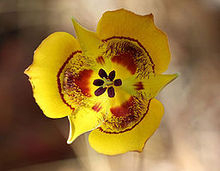
The mainstays of the economy are California Polytechnic State University with its almost 20,000 students, tourism, and agriculture.The economic indicators reveal that San Luis Obispo County aligns closely with California regarding median household income and poverty rates. However, the county distinguishes itself through higher educational attainment and homeownership rates, alongside a distinctive employment sector composition favoring agriculture and related industries. Despite these strengths, the county is not immune to challenges, as evidenced by a housing market that is significantly more expensive than the rest of California and growing income inequality. San Luis Obispo County's economy is primarily a service economy. Service jobs account for 38% of the county's jobs, government jobs accounts for 20.7%, and manufacturing jobs represent 6% of the county's jobs.
San Luis Obispo County is the third largest producer of wine in California, surpassed only by Sonoma and Napa counties. Wine grapes are the second largest agricultural crop in the county (after strawberries),[12] and the wine production they support creates a direct economic impact and a growing wine country vacation industry.
The county led the state in hemp cultivation in 2018 as hundreds of acres of the crop were grown in research partnerships.[33] In 2019, nine agricultural research permits were still active. Sixteen commercial permits were issued before a temporary ban on new applications running through June 2020 was passed by the Board of Supervisors.[34]
Politics
editVoter registration
edit| Population and registered voters | ||
|---|---|---|
| Total population[24] | 267,871 | |
| Registered voters[35][note 3][36] | 184,744 | 58.4% |
| Democratic[35] | 70,180 | 38% |
| Republican[35] | 63,687 | 34.5% |
| Democratic–Republican spread[35] | +6,493 | +3.5% |
| American Independent[35] | 7,116 | 3.9% |
| Green[35] | 972 | 0.5% |
| Libertarian[35] | 2,401 | 1.3% |
| Peace and Freedom[35] | 566 | 0.3% |
| Other[35] | 1,752 | 1% |
| No party preference[35] | 37,366 | 20.2% |
Cities by population and voter registration
edit| Cities by population and voter registration | |||||||
|---|---|---|---|---|---|---|---|
| City | Population[24] | Registered voters[35] [note 3] | Democratic[35] | Republican[35] | D–R spread[35] | Other[35] | No party preference[35] |
| Arroyo Grande | 17,132 | 65.5% | 34.2% | 41.8% | -7.6% | 8.1% | 18.7% |
| Atascadero | 28,194 | 58.9% | 30.8% | 43.9% | -13.1% | 8.2% | 19.8% |
| El Paso de Robles (Paso Robles) | 29,270 | 52.1% | 29.6% | 45.3% | -15.7% | 8.2% | 19.9% |
| Grover Beach | 13,175 | 50.6% | 37.3% | 34.0% | +3.3% | 9.3% | 22.5% |
| Morro Bay | 10,263 | 68.4% | 39.5% | 31.6% | +7.9% | 9.5% | 22.2% |
| Pismo Beach | 7,753 | 70.4% | 32.2% | 41.5% | -9.3% | 8.9% | 20.3% |
| San Luis Obispo | 45,130 | 59.2% | 40.0% | 29.1% | +10.9% | 9.0% | 24.6% |
Overview
editSan Luis Obispo County leaned toward the Republican Party in presidential and congressional elections during most of the 20th century; it has, however, become more Democratic starting in the 2000s. In 2008, Barack Obama won the county with 51.2 percent of the vote.[37] Prior to 2008, the last Democrat to win a majority in the county was Lyndon B. Johnson in 1964, although Bill Clinton won a plurality in 1992. In 2012, Obama again won the county, this time with a slim plurality of the vote. Hillary Clinton won with a larger plurality in 2016; and in 2020, Joe Biden won a solid 55% of the vote, the largest for any Democrat since Johnson.
| Year | Republican | Democratic | Third party | |||
|---|---|---|---|---|---|---|
| No. | % | No. | % | No. | % | |
| 2020 | 67,436 | 42.22% | 88,310 | 55.29% | 3,968 | 2.48% |
| 2016 | 56,164 | 40.94% | 67,107 | 48.91% | 13,931 | 10.15% |
| 2012 | 59,967 | 47.61% | 61,258 | 48.63% | 4,741 | 3.76% |
| 2008 | 61,055 | 45.85% | 68,176 | 51.20% | 3,924 | 2.95% |
| 2004 | 67,995 | 52.69% | 58,742 | 45.52% | 2,313 | 1.79% |
| 2000 | 56,859 | 52.22% | 44,526 | 40.89% | 7,501 | 6.89% |
| 1996 | 46,733 | 46.50% | 40,395 | 40.19% | 13,372 | 13.31% |
| 1992 | 36,384 | 34.78% | 40,136 | 38.36% | 28,099 | 26.86% |
| 1988 | 46,613 | 55.85% | 35,667 | 42.73% | 1,187 | 1.42% |
| 1984 | 49,035 | 63.72% | 26,946 | 35.02% | 969 | 1.26% |
| 1980 | 38,631 | 55.56% | 20,508 | 29.50% | 10,388 | 14.94% |
| 1976 | 27,785 | 51.17% | 24,926 | 45.91% | 1,587 | 2.92% |
| 1972 | 28,566 | 55.98% | 20,779 | 40.72% | 1,688 | 3.31% |
| 1968 | 19,420 | 51.27% | 15,828 | 41.78% | 2,633 | 6.95% |
| 1964 | 14,906 | 40.08% | 22,252 | 59.84% | 28 | 0.08% |
| 1960 | 17,862 | 54.04% | 14,975 | 45.30% | 218 | 0.66% |
| 1956 | 16,223 | 58.47% | 11,407 | 41.11% | 118 | 0.43% |
| 1952 | 17,716 | 65.37% | 9,174 | 33.85% | 213 | 0.79% |
| 1948 | 10,325 | 53.49% | 8,135 | 42.14% | 844 | 4.37% |
| 1944 | 7,793 | 48.90% | 8,068 | 50.63% | 75 | 0.47% |
| 1940 | 7,204 | 45.25% | 8,499 | 53.39% | 217 | 1.36% |
| 1936 | 4,812 | 37.28% | 7,889 | 61.13% | 205 | 1.59% |
| 1932 | 3,449 | 28.59% | 7,933 | 65.77% | 680 | 5.64% |
| 1928 | 5,425 | 60.82% | 3,336 | 37.40% | 159 | 1.78% |
| 1924 | 3,804 | 49.01% | 731 | 9.42% | 3,226 | 41.57% |
| 1920 | 4,123 | 61.31% | 1,606 | 23.88% | 996 | 14.81% |
| 1916 | 2,854 | 40.20% | 3,539 | 49.85% | 706 | 9.95% |
| 1912 | 13 | 0.23% | 2,248 | 40.48% | 3,292 | 59.28% |
| 1908 | 2,008 | 50.76% | 1,381 | 34.91% | 567 | 14.33% |
| 1904 | 2,015 | 54.95% | 1,167 | 31.82% | 485 | 13.23% |
| 1900 | 1,564 | 45.81% | 1,713 | 50.18% | 137 | 4.01% |
| 1896 | 1,671 | 43.74% | 2,056 | 53.82% | 93 | 2.43% |
| 1892 | 1,433 | 38.10% | 1,199 | 31.88% | 1,129 | 30.02% |
| 1888 | 1,689 | 49.68% | 1,585 | 46.62% | 126 | 3.71% |
| 1884 | 1,233 | 51.44% | 1,069 | 44.60% | 95 | 3.96% |
| 1880 | 830 | 47.81% | 729 | 41.99% | 177 | 10.20% |
County voters last supported a Republican gubernatorial candidate in 2010; since 2014, San Luis Obispo County has reliably gone to the Democratic candidates. The previous Democrat to carry the county in a gubernatorial election prior to 2010 was Gray Davis in 1998.
With respect to the United States House of Representatives, San Luis Obispo County is mostly in California's 24th congressional district, represented by Democrat Salud Carbajal, with the northern part of the county in California's 19th congressional district, represented by Democrat Jimmy Panetta.[39] From 2003 until 2013, the county was split between the Bakersfield-based 22nd district, which was represented by Republican Kevin McCarthy and included Paso Robles and most of the more conservative inland areas of the county, and Lois Capps' 23rd district, a strip which included most of the county's more liberal coastal areas as well as coastal areas of Santa Barbara and Ventura counties.
With respect to the California State Senate, the county is in the 17th Senate District, represented by Democrat John Laird. With respect to the California State Assembly, the county is in the 30th Assembly District, represented by Democrat Dawn Addis.
In April 2008, the California Secretary of State reported that there were 147,326 registered voters in San Luis Obispo County. Of those voters, 61,226 (41.6%) were registered Republicans, 52,586 (35.7%) were registered Democratic, 8,030 (5.4%) are registered with other political parties, and 25,484 (17.3%) declined to state a political preference. The cities of Grover Beach, Morro Bay, and San Luis Obispo had pluralities or majorities of registered Democratic voters, whereas the rest of the county's towns, cities, and the unincorporated areas have a plurality or majority of registered Republican voters.[citation needed]
Crime
editThe following table includes the number of incidents reported and the rate per 1,000 persons for each type of offense.
| Population and crime rates | ||
|---|---|---|
| Population[24] | 267,871 | |
| Violent crime[40] | 694 | 2.59 |
| Homicide[40] | 4 | 0.01 |
| Forcible rape[40] | 89 | 0.33 |
| Robbery[40] | 106 | 0.40 |
| Aggravated assault[40] | 495 | 1.85 |
| Property crime[40] | 3,009 | 11.23 |
| Burglary[40] | 1,433 | 5.35 |
| Larceny-theft[40][41] | 4,169 | 15.56 |
| Motor vehicle theft[40] | 375 | 1.40 |
| Arson[40] | 88 | 0.33 |
Cities by population and crime rates
edit| Cities by population and crime rates | ||||||||
|---|---|---|---|---|---|---|---|---|
| City | Population[42] | Violent crimes[42] | Violent crime rate per 1,000 persons | Property crimes[42] | Property crime rate per 1,000 persons | |||
| Arroyo Grande | 17,568 | 60 | 3.42 | 358 | 20.38 | |||
| Atascadero | 28,825 | 192 | 6.66 | 658 | 22.83 | |||
| Grover Beach | 13,398 | 32 | 2.39 | 306 | 22.84 | |||
| Morro Bay | 10,423 | 21 | 2.01 | 140 | 13.43 | |||
| Paso Robles | 30,344 | 91 | 3.00 | 777 | 25.61 | |||
| Pismo Beach | 7,798 | 36 | 4.62 | 305 | 39.11 | |||
| San Luis Obispo | 45,947 | 119 | 2.59 | 1,971 | 42.90 | |||
Fire protection
edit| Agency overview | |
|---|---|
| Annual calls | Approximately 20,000 |
| Annual budget | 25 million |
| Facilities and equipment | |
| Battalions | 5 |
| Stations | 21 |
| Engines | 17 - first run 5 - reserve |
| Rescues | 2 |
| Tenders | 3 |
| HAZMAT | 1 |
| USAR | 2 |
| Airport crash | 2 |
| Wildland | 2 - type 3 |
| Light and air | 1 |
| Website | |
| Official website | |
In unincorporated parts of the county, fire protection and emergency response services have been provided by the San Luis Obispo County Fire Department, a division of CAL FIRE, since 1930. The county fire department also serves Los Osos, Pismo Beach and Avila Beach.[43] The city of San Luis Obispo is served by the San Luis Obispo City Fire Department.
Transportation
editMajor highways
editPublic transportation
editSan Luis Obispo County is served by Amtrak trains and Greyhound Lines buses.The San Luis Obispo Regional Transit Authority provides countywide service along US 101 as well as service to Morro Bay, Los Osos, Cambria and San Simeon.
The cities of San Luis Obispo, Atascadero and Paso Robles operate their own local bus services; all of these connect with SLORTA routes.
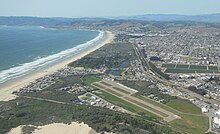
Intercity service is provided by Amtrak trains, Greyhound Lines and Orange Belt Stages buses.
The Amtrak Thruway 18 provides a daily connection to Visalia on the east, and Santa Maria on the west, with several stops in between.[44]
FlixBus boards from the San Luis Obispo Railroad Museum at 1940 Santa Barbara Avenue.
Airports
edit- San Luis Obispo County Regional Airport (SBP) is located just south of the City of San Luis Obispo. Commercial flights are available.
- Paso Robles Municipal Airport (PRB) is located north-east of the City of Paso Robles and is home to California Highway Patrol, CAL-FIRE and the Estrella Warbirds Museum.
- Oceano County Airport (L52) is located on the coast in the 5 Cities area.
Future
editIn the future, SR 46 may be considered for a possible westward expansion of Interstate 40 via SR 58 from Barstow to Bakersfield, from Bakersfield to I-5 via Westside Parkway, and then following SR 46 to Paso Robles.[45] SR 46 is slowly being upgraded to Interstate standards, minus overpasses between Interstate 5 and US Route 101.
Communities
editCities
editUnincorporated communities
edit- Avila Beach[note 4]
- Baywood Park
- Blacklake[note 4]
- California Polytechnic State University[note 4]
- California Valley
- Callender[note 4]
- Cambria[note 4]
- Cayucos[note 4]
- Creston[note 4]
- Cholame
- Edna[note 4]
- Garden Farms[note 4]
- Halcyon
- Harmony
- Lake Nacimiento[note 4]
- Los Berros[note 4]
- Los Osos[note 4]
- Los Ranchos[note 4]
- Nipomo[note 4]
- Oak Shores[note 4]
- Oceano[note 4]
- Pozo
- San Miguel[note 4]
- San Simeon[note 4]
- Santa Margarita[note 4]
- Shandon[note 4]
- Templeton[note 4]
- Whitley Gardens[note 4]
- Woodlands[note 4]

Population ranking
editThe population ranking of the following table is based on the 2020 census of San Luis Obispo County.[46]
† county seat
| Rank | City/Town/etc. | Municipal type | Population (2020 Census) |
|---|---|---|---|
| 1 | † San Luis Obispo | City | 47,063 |
| 2 | Paso Robles (El Paso de Robles) | City | 31,490 |
| 3 | Atascadero | City | 29,773 |
| 4 | Arroyo Grande | City | 18,441 |
| 5 | Nipomo | CDP | 18,176 |
| 6 | Los Osos | CDP | 14,465 |
| 7 | Grover Beach | City | 12,701 |
| 8 | Morro Bay | City | 10,757 |
| 9 | Templeton | CDP | 8,386 |
| 10 | Pismo Beach | City | 8,072 |
| 11 | Oceano | CDP | 7,183 |
| 12 | Cambria | CDP | 5,678 |
| 13 | San Miguel | CDP | 3,172 |
| 14 | Lake Nacimiento | CDP | 2,956 |
| 15 | Cayucos | CDP | 2,505 |
| 16 | Woodlands | CDP | 1,933 |
| 17 | Avila Beach | CDP | 1,576 |
| 18 | Los Ranchos | CDP | 1,516 |
| 19 | Santa Margarita | CDP | 1,291 |
| 20 | Callender | CDP | 1,282 |
| 21 | Shandon | CDP | 1,168 |
| 22 | Blacklake | CDP | 1,016 |
| 23 | Los Berros | CDP | 623 |
| 24 | Garden Farms | CDP | 449 |
| 25 | San Simeon | CDP | 445 |
| 26 | Whitley Gardens | CDP | 325 |
| 27 | Oak Shores | CDP | 316 |
| 28 | Edna | CDP | 184 |
| 29 | Creston | CDP | 98 |
See also
edit- San Luis Obispo County Search and Rescue
- List of museums in the California Central Coast
- List of school districts in San Luis Obispo County, California
- National Register of Historic Places listings in San Luis Obispo County, California
- San Luis Obispo Pioneer, the county's first newspaper
- Dalidio Ranch Project, a development proposal in San Luis Obispo County
- Amphibious Training Base Morro Bay
Notes
edit- ^ Other = Some other race + Two or more races
- ^ Native American = Native Hawaiian or other Pacific Islander + American Indian or Alaska Native
- ^ a b Percentage of registered voters with respect to total population. Percentages of party members with respect to registered voters follow.
- ^ a b c d e f g h i j k l m n o p q r s t u v w For statistical purposes, defined by the United States Census Bureau as a census-designated place (CDP).
Footnotes
editFurther reading
edit- Charles Montville Gidney, Benjamin Brooks, and Edwin M. Sheridan, History of Santa Barbara, San Luis Obispo and Ventura Counties, California. In Two Volumes. Chicago: Lewis Publishing Co., 1917. Volume 1 | Volume 2
- Yda Addis Storke, A Memorial and Biographical History of the Counties of Santa Barbara, San Luis Obispo and Ventura, California... Chicago: Lewis Publishing Co., 1891.
External links
edit
